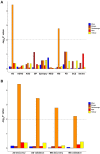Cell-Type-Specific Gene Modules Related to the Regional Homogeneity of Spontaneous Brain Activity and Their Associations With Common Brain Disorders
- PMID: 33958982
- PMCID: PMC8093778
- DOI: 10.3389/fnins.2021.639527
Cell-Type-Specific Gene Modules Related to the Regional Homogeneity of Spontaneous Brain Activity and Their Associations With Common Brain Disorders
Abstract
Mapping gene expression profiles to neuroimaging phenotypes in the same anatomical space provides opportunities to discover molecular substrates for human brain functional properties. Here, we aimed to identify cell-type-specific gene modules associated with the regional homogeneity (ReHo) of spontaneous brain activity and their associations with brain disorders. Fourteen gene modules were consistently associated with ReHo in the three datasets, five of which showed cell-type-specific expression (one neuron-endothelial module, one neuron module, one astrocyte module and two microglial modules) in two independent cell series of the human cerebral cortex. The neuron-endothelial module was mainly enriched for transporter complexes, the neuron module for the synaptic membrane, the astrocyte module for amino acid metabolism, and microglial modules for leukocyte activation and ribose phosphate biosynthesis. In enrichment analyses of cell-type-specific modules for 10 common brain disorders, only the microglial module was significantly enriched for genes obtained from genome-wide association studies of multiple sclerosis (MS) and Alzheimer's disease (AD). The ReHo of spontaneous brain activity is associated with the gene expression profiles of neurons, astrocytes, microglia and endothelial cells. The microglia-related genes associated with MS and AD may provide possible molecular substrates for ReHo abnormality in both brain disorders.
Keywords: Allen Human Brain Atlas; cell type; fMRI; gene expression; regional homogeneity.
Copyright © 2021 Shen, Yang, Xie, Wu, Zheng, Wang, Wang, Zhang, Li, Ye and Yu.
Conflict of interest statement
The authors declare that the research was conducted in the absence of any commercial or financial relationships that could be construed as a potential conflict of interest.
Figures






Similar articles
-
Cell type characterization of spatiotemporal gene co-expression modules in Down syndrome brain.iScience. 2022 Dec 28;26(1):105884. doi: 10.1016/j.isci.2022.105884. eCollection 2023 Jan 20. iScience. 2022. PMID: 36647384 Free PMC article.
-
Uncovering neuroinflammation-related modules and potential repurposing drugs for Alzheimer's disease through multi-omics data integrative analysis.Front Aging Neurosci. 2023 Jun 2;15:1161405. doi: 10.3389/fnagi.2023.1161405. eCollection 2023. Front Aging Neurosci. 2023. PMID: 37333458 Free PMC article.
-
The Transcriptional Landscape of Microglial Genes in Aging and Neurodegenerative Disease.Front Immunol. 2019 Jun 4;10:1170. doi: 10.3389/fimmu.2019.01170. eCollection 2019. Front Immunol. 2019. PMID: 31214167 Free PMC article.
-
Altered spontaneous activity in Alzheimer's disease and mild cognitive impairment revealed by Regional Homogeneity.Neuroimage. 2012 Jan 16;59(2):1429-40. doi: 10.1016/j.neuroimage.2011.08.049. Epub 2011 Aug 30. Neuroimage. 2012. PMID: 21907292
-
Genetic perturbations of disease risk genes in mice capture transcriptomic signatures of late-onset Alzheimer's disease.Mol Neurodegener. 2019 Dec 26;14(1):50. doi: 10.1186/s13024-019-0351-3. Mol Neurodegener. 2019. PMID: 31878951 Free PMC article.
Cited by
-
Imaging Transcriptomics of Brain Functional Alterations in MS and Neuromyelitis Optica Spectrum Disorder.AJNR Am J Neuroradiol. 2024 Dec 9;45(12):1901-1909. doi: 10.3174/ajnr.A8480. AJNR Am J Neuroradiol. 2024. PMID: 39510804
-
Genetic mechanisms underlying local spontaneous brain activity in episodic migraine.Front Neurosci. 2024 Feb 6;18:1348591. doi: 10.3389/fnins.2024.1348591. eCollection 2024. Front Neurosci. 2024. PMID: 38379763 Free PMC article.
-
Abnormal eye movement, brain regional homogeneity in schizophrenia and clinical high-risk individuals and their associated gene expression profiles.Schizophrenia (Heidelb). 2025 Apr 17;11(1):64. doi: 10.1038/s41537-025-00609-x. Schizophrenia (Heidelb). 2025. PMID: 40246913 Free PMC article.
-
Cognitive implications and associated transcriptomic signatures of distinct regional iron depositions in cerebral small vessel disease.Alzheimers Dement. 2025 Apr;21(4):e70196. doi: 10.1002/alz.70196. Alzheimers Dement. 2025. PMID: 40257048 Free PMC article.
References
LinkOut - more resources
Full Text Sources
Other Literature Sources

